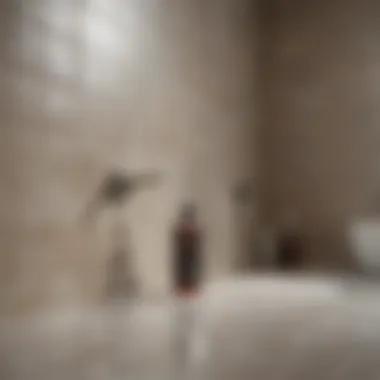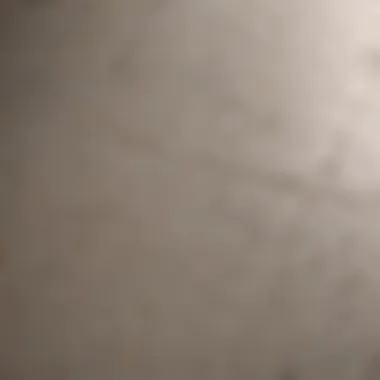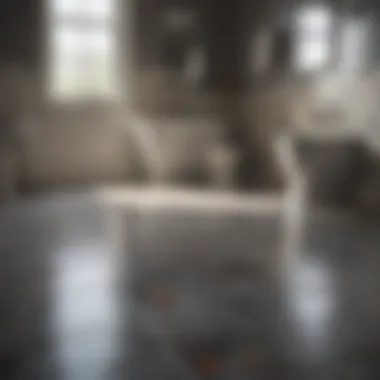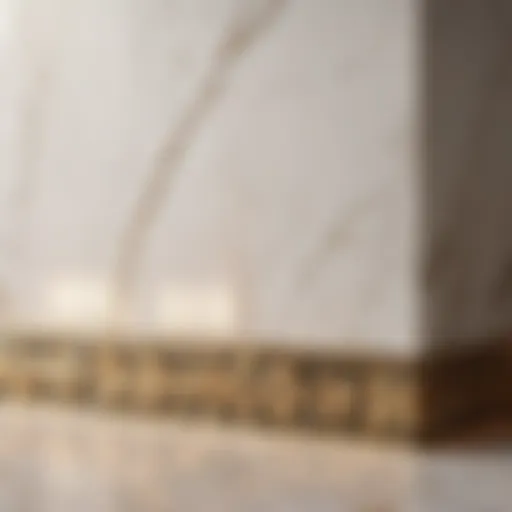Understanding Bathroom Tile Sealer Spray: A Guide


Intro
Maintaining the elegance and durability of bathroom tiles often requires a well-thought-out approach. One crucial aspect is the application of tile sealer sprays. These products not only enhance the longevity of tiles but also preserve their aesthetic appearance. In this guide, we will explore everything from the materials needed for this task to the step-by-step DIY processes, plus the technical aspects that ensure a clean and effective tile sealing.
Materials:
Before embarking on this project, it’s important to gather the right materials. Below is a comprehensive list:
- Tile sealer spray: 1 can, ensure it is compatible with your tile material.
- Cleaning solution: 1 quart, a pH-neutral cleaner is recommended.
- Soft cloths: 5 pieces, for cleaning and drying tiles.
- Masking tape: 1 roll, used to protect areas not intended for sealing.
- Drop cloths or newspaper: Enough to cover adjacent surfaces and floors.
- Safety goggles: 1 pair, to protect eyes from fumes.
- Gloves: 1 pair, for safety against chemicals.
DIY Steps:
Step 1: Preparation
- Ensure the bathroom is well-ventilated. Open windows and doors. Use fans if necessary.
- Gather all materials and lay out your drop cloths to protect the area.
Step 2: Clean the Surface
- Use a pH-neutral cleaning solution to thoroughly clean the tiles.
- Apply the cleaning solution with a soft cloth, scrubbing gently.
- Rinse with clean water and dry the area completely with another soft cloth.
Step 3: Protective Measures
- Apply masking tape to edges where tiles meet other surfaces to prevent sealer from getting on unwanted areas.
Step 4: Apply the Tile Sealer Spray
- Shake the tile sealer can well before use. Hold it at a distance of about 6-12 inches from the tile surface. Spray evenly.
- Use a back-and-forth motion for even coverage, ensuring you do not over-saturate.
Step 5: Allow to Dry
- Let the sealer dry as per the manufacturer's instructions, typically around 1-2 hours for surface drying.
Step 6: Apply a Second Coat
- After the first coat has dried, assess if a second coat is necessary. If so, repeat the application process.
Step 7: Final Cleanup
- Once fully dry, remove all masking tape carefully.
- Dispose of any waste materials appropriately.
Technical Aspects:
Tools Needed
- Sprayer (included in the spray can).
- Cloth for cleaning.
- Masking tape for edges.
Timing Specifics
- Cleaning: 15-30 minutes.
- Drying time: 1-2 hours.
- Application time for the sealant: 20 minutes per coat.
Critical Techniques
- Always spray from a consistent distance for even application.
- Ensure no wind is blowing during application to avoid dust settling on wet sealer.
DIY Project Process:
Sequential Steps
- Prepare and clean as discussed.
- Protect surrounding areas with cloth and masking tape.
- Apply the sealer spray using the correct techniques.
- Allow proper drying time.
- Assess and potentially reapply for additional protection.
Troubleshooting Tips
- If uneven surface is noticed after drying, lightly sand the area and reapply the sealer.
- Should streaks appear, it may indicate over-saturation. Ensure to follow spray guidelines closely.
"Applying tile sealer spray can significantly reduce water damage and staining, leading to a longer lifespan for your bathroom surfaces."
By following these guidelines meticulously, homeowners can ensure their bathroom tiles not only look good but also last longer in optimal condition.
Preamble to Bathroom Tile Sealer Spray
When it comes to maintaining the beauty and functionality of bathroom tiles, understanding bathroom tile sealer spray is crucial. This section serves as a stepping stone into the world of sealers, explaining not only what they are but also why they are important. A well-sealed tile surface can significantly enhance the bathroom's overall aesthetic and longevity, making it imperative for homeowners to grasp these concepts.
Definition of Tile Sealer Spray
Tile sealer spray is a type of protective coating specifically formulated for porous surfaces. These sprays create a barrier that prevents water, stains, and other damaging substances from penetrating the tile or grout. Generally, these products come in aerosol cans or bottles, allowing for easy application on various tile types, including ceramic, porcelain, and natural stone.
Applying tile sealer spray involves spraying a fine mist over the surface, allowing it to soak into the material. Unlike traditional sealers, which can often be messy and time-consuming to apply, sealers in spray form provide convenience and efficiency.
Importance of Sealing Bathroom Tiles


Sealing bathroom tiles is not just a matter of aesthetics; it is a fundamental aspect of tile care. Tiles in bathrooms are subjected to frequent moisture and potential staining agents, such as soap, shampoos, and other cleaning products. Sealing these surfaces helps in multiple ways:
- Preventing Water Damage: Sealers create a protective shield against moisture, thus minimizing the risk of mold and mildew growth.
- Stain Protection: Regular exposure to potential staining agents is common in bathrooms. A properly sealed tile surface helps repel these substances, keeping tiles looking new and clean.
- Ease of Maintenance: Sealed tiles can be cleaned more easily. Dirt and grime do not adhere as firmly to sealed surfaces, allowing for simple cleaning routines.
Inadequately sealed tiles can lead to significant maintenance costs over time, as repairs and replacements might become necessary.
Overview of Types of Sealers
In understanding bathroom tile sealer spray, it is crucial to recognize the different types of sealers available on the market. Each type serves a unique purpose, offering various levels of protection and aesthetic enhancement. The choice of sealer can significantly influence the longevity and appearance of the tiles. This section will detail penetrating sealers, topical sealers, and eco-friendly options, providing insights into their functions and applications.
Penetrating Sealers
Penetrating sealers, as the name suggests, have the ability to seep into the porous surface of tiles and grout. They usually contain silane and siloxane compounds that form a barrier within the material. This protection prevents moisture and stains from penetrating further and damaging the tile or substrate. Penetrating sealers are often preferred for natural stone tiles, such as granite or marble, as they allow the stone to breathe while protecting it from stains and discoloration.
Benefits of using penetrating sealers include:
- Long-lasting protection: With proper application, these sealers can last several years.
- Natural look: They enhance the tile's natural color without creating a glossy finish.
- Mold and mildew resistance: By keeping moisture out, they help inhibit the growth of mold and mildew.
However, they require careful application and a more extended curing time, which is essential for achieving optimal results.
Topical Sealers
Topical sealers create a protective layer on the surface of tiles. They can be either water-based or solvent-based and often contain acrylics or urethanes. This type of sealer provides a barrier against moisture, stains, and scratches. Topical sealers are commonly used on ceramic and porcelain tiles, where a high-gloss finish is desired.
Key points regarding topical sealers include:
- Immediate results: These sealers are often easier to apply and cure faster than penetrating options.
- Enhanced shine: Topical sealers can give tiles a shiny, polished look that many homeowners appreciate.
- Frequent maintenance: Despite their initial effectiveness, topical sealers may need to be reapplied more often than penetrating sealers due to wear and tear.
Consideration of the specific tile type and desired aesthetic is important in deciding if a topical sealer is the right fit.
Eco-Friendly Options
Increasing awareness of environmental issues has led to the development of eco-friendly sealers. These products use natural ingredients and sustainable practices to create a safer option for households. They can be made from plant-based oils and waxes, offering protection without harsh chemicals. Eco-friendly sealers can be just as effective as traditional options, especially for those keen on maintaining healthier indoor air quality.
Benefits of eco-friendly sealers include:
- Minimal chemical exposure: They are generally safer for families and pets.
- Sustainability: Eco-friendly products are often created with renewable resources, reducing environmental impact.
- Versatility: These sealers can work on various surfaces, including tiles and grout, providing comprehensive protection.
"Choosing the right type of sealer is crucial for protecting your investment in tiles and enhancing your home’s aesthetic appeal."
Components of Tile Sealer Spray
Understanding the components of tile sealer spray is essential for making informed choices about tile maintenance. These components determine not only the effectiveness of the sealant but also its longevity and safety for use in home environments. Here, we will discuss two major aspects: the active ingredients and the propellants used in tile sealer sprays.
Active Ingredients and Their Functions
Active ingredients are the core of any tile sealer spray. They play a crucial role in how effectively the spray protects tiles from moisture and stains. Common active ingredients include silicone compounds, fluoropolymers, and acrylics, each with unique properties.
- Silicone Compounds: These create a waterproof barrier on the surface of tiles. They are particularly good for areas with high moisture, like bathrooms, as they repel water and prevent mold growth.
- Fluoropolymers: Known for their resistance to stains, fluoropolymers are effective in keeping surfaces clean. They do this by reducing the surface tension, making it hard for stains to adhere.
- Acrylics: While they do not provide the same level of water resistance as silicone, acrylics can enhance the gloss and overall appearance of the tiles. They often protect against light stains and scratches.
In addition to these primary components, some sealers may include agents that help with adhesion or color enhancement. Selecting a spray that contains suitable active ingredients for your specific tile type ensures optimal protection and durability.
Propellants and Application Mechanisms
The propellants used in tile sealer sprays can significantly impact how easily and evenly the product is applied. Common propellants include hydrocarbons and compressed gases.
- Hydrocarbons: These are traditional propellants often found in aerosol sprays. They provide good coverage but must be used cautiously due to flammability concerns. Proper ventilation is advisable during application to minimize inhalation risks.
- Compressed Gases: These are more environmentally friendly and less hazardous compared to hydrocarbons. However, their performance may vary by temperature and altitude. They can result in finer, more controllable spray patterns.
During application, the method also matters. The most common application methods are aerosol spraying, brush application, and roller use. Each method has its advantages:
- Aerosol Spraying: Allows for quick and even distribution. Ideal for large areas but may result in overspray.
- Brush Application: Provides more control, especially in tight spaces. However, it may take longer and requires more effort.
- Roller Use: Good for larger, flat surfaces, giving a consistent finish. It can be harder to use in detailed areas.
Choosing the Right Tile Sealer Spray
Choosing the right tile sealer spray is vital for ensuring the longevity and appearance of your tiled surfaces. Selecting an appropriate product can protect against moisture, stains, and damage, while also enhancing the overall aesthetic of the tiles. An informed decision can save time and money in the long run, reducing the frequency of necessary repairs or maintenance.
Factors to Consider
When selecting a tile sealer spray, several factors require careful consideration to ensure it aligns with your specific needs.
Tile Material
The type of tile material significantly influences the choice of sealer. Porous tiles, like unglazed ceramic or natural stone, require penetrating sealers, which can absorb into the tile. This absorption provides deeper protection against moisture and stains. Conversely, glazed tiles are less porous and may benefit from topical sealers that form a protective layer on the surface. Understanding the unique properties of your tile material helps you choose a suitable sealer and enhance its overall effectiveness.
Location and Exposure
The location of tiles and their exposure also play a critical role. Tiles in high-moisture areas, such as showers, need sealers that provide high resistance to water. Additionally, external tiles may require sealers that can withstand UV exposure and changing weather conditions. Evaluating the conditions your tiles face ensures that the sealer chosen offers longevity and adequate protection, keeping surfaces intact and visually appealing.
Expected Wear and Tear


Anticipating the level of wear and tear helps determine the right sealer as well. Areas with heavy foot traffic or frequent use demand more robust sealants. Choosing a durable product can prevent premature deterioration and reduce the need for frequent reapplications. Understanding the unique stresses that your tiles will undergo ensures that the selected sealant can withstand their daily use, maintaining the tiles' integrity over time.
Top Brands Overview
When it comes to tile sealer sprays, several brands stand out for their effectiveness and reliability. Some popular names include:
- Aqua Mix: Known for its comprehensive range of quality sealers suitable for various tile types.
- Miracle Sealants: Offers advanced and eco-friendly options, ensuring minimal impact on the environment.
- StoneTech: Provides sealers designed specifically for natural stone tiles, meeting high standards of protection.
Researching and comparing the features of these brands can help you select a product that meets both your needs and expectations.
Application Process of Tile Sealer Spray
The application process of tile sealer spray is pivotal for anyone aiming to protect bathroom tiles properly. Understanding the steps involved ensures effective sealing, which can significantly enhance the durability and appearance of your tiles. This section will discuss the essential stages of application, including surface preparation, different application techniques, and the importance of curing time and conditions.
Preparation of the Surface
Before applying tile sealer spray, the surface requires thorough cleaning. Any dirt, grease, or old stains must be removed. A clean surface ensures that the sealer adheres properly, providing better protection. Using mild cleaning solutions that do not contain harsh chemicals is advisable. After cleaning, allow the tiles to dry completely. This step is crucial, as moisture trapped under the sealer can lead to mold or mildew growth. It is wise to inspect for any cracks or damage in the tiles. Addressing these issues beforehand can also extend the lifespan of the sealed surface.
Application Techniques
Choosing the right application technique is essential for a successful sealing process. There are several methods available, each with its own set of benefits and challenges. Below are the main techniques:
Aerosol Spraying
Aerosol spraying is a popular method for applying tile sealer spray. It allows for an even distribution of the product, which is important for comprehensive coverage. One of the key characteristics of aerosol spraying is its convenience. The spray can reach tight spaces and corners that may be hard to access. It can also dry quickly, reducing the time between coats. However, users must be cautious about overspray, which can lead to unintended coatings on surrounding areas.
Brush Application
Brush application provides more control compared to aerosol spraying. This method is particularly effective for detailed work, such as around fixtures or intricate tile patterns. A key feature of brush application is that it allows for working the sealer into the tile pores, enhancing penetration and adhesion. While this method gives a more hands-on experience, it can be time-consuming, especially for larger areas. Additionally, achieving a uniform application might require more effort and skill.
Roller Use
Using rollers for application offers a balance between speed and control. Rollers can cover large areas swiftly, making them suitable for bigger spaces. A distinct advantage of using a roller is the consistent pressure applied, which can lead to an even coat. However, caution is needed to ensure that the roller does not apply too much product at once, which might create a thick layer that takes longer to dry.
Curing Time and Conditions
Curing time refers to the period required for the sealer to adequately bond with the tile surface. Typically, curing time can vary based on the specific product used and environmental conditions. Factors like humidity and temperature can significantly influence the curing process. It is essential to follow the manufacturer's guidelines regarding curing time. During this period, it is best to avoid using the tiled area to ensure optimal adhesion. A well-cured sealant will effectively protect against moisture, stains, and general wear.
"Preparing the surface correctly and ensuring proper curing are the foundation of a successful tile sealing project. Without these, even the best products may fail to deliver ideal results."
By understanding these facets of tile sealer application, homeowners can make educated choices that lead to better results in their bathroom maintenance efforts.
Benefits of Using Bathroom Tile Sealer Spray
Using bathroom tile sealer spray comes with several advantages that enhance the longevity and appearance of your tiled surfaces. These benefits extend beyond aesthetics and impact functionality as well. Understanding these benefits is crucial for homeowners who want to maintain a pleasing and durable bathroom environment.
Protection Against Stains and Moisture
One of the primary benefits of tile sealer spray is its ability to protect tiles against stains and moisture. Bathrooms are naturally humid spaces. The constant presence of water can lead to discoloration and mildew growth. Applying a sealer ensures that water and other liquids bead up on the surface rather than penetrate into the tiles.
Stains from soap, toothpaste, and other bathroom products can become a headache to clean if they seep into tile grout. Sealing provides a barrier that helps to prevent permanent staining.
"A quality sealer can significantly reduce the amount of cleaning required, making your efforts more effective over time."
Enhanced Lifespan of Tiles
The durability of bathroom tiles can greatly benefit from the application of a sealer. Tiles that are not sealed may suffer from wear due to moisture and harsh cleaning products. This deterioration can lead to cracks and chips. By shielding them from these damaging elements, you enhance their lifespan.
Moreover, the preparation involved in sealing can sometimes strengthen grout joints, making them less susceptible to cracking. This leads to fewer tiles needing replacement over time, thus saving you money in renovation costs.
Improved Aesthetic Appeal
Bathroom tiles play a significant role in the overall aesthetic of the space. Often, dull or stained tiles can detract from the overall look of a bathroom. A good tile sealer spray can restore and maintain the visual appeal of both tiles and grout.
When tiles are sealed properly, their colors become more vibrant, and the whole area appears more polished. This approach can create a fresh, updated look without the expense of a full renovation.
In summary, using bathroom tile sealer spray is essential for not only preserving the physical integrity of tiles but also for enhancing their beauty and functionality in a moisture-rich environment.
Possible Drawbacks and Considerations
When considering the use of bathroom tile sealer spray, it is essential to be aware of the possible drawbacks and considerations. This awareness helps homeowners make informed decisions about whether or not to proceed with sealing their tiles. While sealants offer numerous benefits, understanding potential limitations can prevent unforeseen issues down the line.
Chemical Reactions with Certain Materials
Tile sealers are typically formulated to be effective on a wide range of surfaces. However, they may react negatively with certain materials, which can lead to damages. For instance, if a tile is made from a porous stone like limestone or marble, using the wrong type of sealer can cause discoloration or deterioration.
Moreover, some brands contain solvents that can harm rubber or plastic fixtures nearby. Homeowners should always check compatibility before applying sealers. It is advisable to conduct a small patch test in an inconspicuous area to see how the sealer interacts with the material.
As a general guideline, always read the product label and understand the recommended applications. If uncertain, consulting the manufacturer or a professional may prevent costly mistakes and maintain the aesthetic qualities of your tiles.


Need for Regular Maintenance
Applying a tile sealer is not a one-time effort. Regular maintenance is crucial to ensure the longevity of the sealant and the tiles it protects. Over time, wear and tear from foot traffic, moisture, and cleaning products can break down sealers, diminishing their effectiveness.
To keep sealed tiles in optimal condition, homeowners should establish a routine cleaning schedule. This includes:
- Using appropriate cleaning solutions: Avoid harsh chemicals that can degrade the sealer.
- Avoiding excessive water: While tiles are often water-resistant, over-saturation can weaken the bond of the sealer.
Additionally, determining when to reapply the sealer is vital. Signs that resealing may be needed include:
- Loss of shine or luster: A dull appearance may indicate that the protective layer has worn off.
- Stains: If stains develop more easily on the surface, the sealer may no longer be effective.
In summary, being proactive in maintenance not only prolongs tile lifespan but also ensures the desired look and hygiene levels are maintained. Overall, understanding these drawbacks is integral for effective tile care.
Long-term Maintenance of Sealed Tiles
Effective long-term maintenance of sealed tiles is crucial for preserving their appearance and functionality. Regular care not only enhances the lifespan of the tiles but also maintains their aesthetic appeal. Sealed tiles are more resistant to moisture, stains, and wear, but they still require attention to ensure their integrity over time. Skipping maintenance can lead to deterioration, decreasing their durability and necessitating more frequent resealing.
Regular cleaning practices help remove dirt and other residues that can accumulate on the surface of tiles. A routine that integrates appropriate cleaning techniques is essential to retain the effectiveness of the sealer and to avoid any buildup that could compromise the seal.
Routine Cleaning Practices
To maintain sealed tiles effectively, homeowners should adopt a simple yet thorough cleaning routine. It is advisable to use a pH-neutral cleaner designed for tiled surfaces. Avoid harsh chemicals as they can degrade both the sealer and the tiles themselves. An approach that incorporates the following practices can be beneficial:
- Frequent Sweeping or Vacuuming: Prevent dirt and grit from scratching the surface.
- Damp Mopping: Use a damp mop with a mild cleaner to remove stains and maintain shine.
- Spot Cleaning: Address spills immediately to prevent stains from setting.
- Avoiding Excessive Water: Do not soak the tiles as excessive moisture can weaken the seal.
Maintaining these routines will ensure that the tiles remain in optimal condition and that the benefits of the sealer last.
Reapplication Schedule
Reapplication of the sealant is necessary to keep the tiles protected from moisture and stains. The frequency of resealing can vary, depending on several factors.
Factors Influencing Frequency
The frequency of resealing depends largely on the type of sealer used, the material of the tiles, and the level of foot traffic in the area. Common factors include:
- Tile Material: Porous materials such as natural stone require more frequent sealing compared to ceramic tiles.
- Location and Use: High-traffic areas or areas with more exposure to water, like bathrooms, may need resealing sooner.
- Quality of Initial Seal: Higher-quality sealers may last longer than budget options, influencing how often resealing is needed.
Identifying the right schedule ensures maximum protection for your tiles and prevents damage over time.
Signs That Resealing Is Needed
Recognizing the signs outlining when resealing is necessary can save homeowners from future costly repairs. Key indicators include:
- Loss of Shine: Dullness or lack of luster indicates the sealer may be wearing off.
- Stains Tracking: If spills leave stains that persist despite cleaning, it points to a compromised seal.
- Water Absorption: If water absorbs quickly into the tile rather than beading up on the surface.
Paying attention to these signs helps maintain the integrity of your tiled surfaces and minimize long-term damage. Regular maintenance and timely resealing ensure that your investment in sealed tiles continues to deliver benefits, preserving both beauty and functionality.
Alternative Methods and Products
The realm of tile sealing is increasingly diverse, importing options beyond traditional chemical sealers. Embracing alternative methods and products has importance both for environmental sustainability and cost-saving strategies. Understanding these alternatives is essential for homeowners seeking effective solutions to maintain their bathroom tiles.
Natural Sealers
Natural sealers have gained traction due to their eco-friendliness and non-toxic properties. Many of these products utilize plant-based or mineral ingredients that provide a protective layer without introducing harmful chemicals into the home environment. One benefit of natural sealers is that they often enhance the natural beauty of the tile rather than altering its appearance.
Examples of natural sealers include:
- Beeswax: Often used on porous tiles, beeswax creates a moisture-resistant film that protects against stains. It requires regular reapplication but is very effective.
- Olive Oil and Vinegar Mixture: A common household solution, this combination can provide basic sealing properties while cleaning. It is not a long-term solution but works well for maintenance.
It is important to note the versatility of natural sealers. They are compatible with many types of materials such as ceramic and stone but may lack the longevity of synthetic sealers. Homeowners should consider their specific needs when choosing these products.
DIY Sealant Solutions
Do-it-yourself (DIY) sealant solutions are another practical alternative for tile care. Crafting your own sealer often requires straightforward household items, which can make it a budget-friendly option. However, one must understand the potential limitations of DIY solutons.
Creating a simple DIY tile sealer might involve using a mixture of water, vinegar, and a small amount of dish soap. This mixture can help in cleaning tiles and provide some degree of protection against stains.
Considerations for DIY solutions include:
- Effectiveness: DIY sealers may not last as long as commercial products, and they might not provide adequate protection against heavy moisture in areas like bathrooms.
- Customization: Homeowners can adjust the mixture to suit the tiles' requirements, which may be beneficial for unique situations.
- Full Coverage Challenge: Achieving uniform coverage might be trickier with DIY applications compared to prepackaged sprays.
Closure
In assessing and maintaining your bathroom's tiled surfaces, understanding the concept of sealing becomes vital. This article elucidates the multifaceted advantages of using tile sealer sprays, emphasizing their role in protecting against moisture and stains, while ensuring an aesthetic appeal that resonates with your home's overall image. The conclusion serves not only to recap the essential takeaways but also to reinforce the importance of ongoing care and maintenance.
Recap of Key Points
- Definition and Importance: Tile sealer spray is integral for preserving the integrity of bathroom tiles, preventing damage from moisture and wear. Proper sealing prolongs tile life significantly.
- Types of Sealers: The two main categories discussed—penetrating and topical sealers—each offer distinct benefits depending on tile materials and location. Understanding these differences helps in selecting the right product.
- Application and Maintenance: A well-outlined application process ensures optimal efficacy of the sealer. Furthermore, establishing a reapplication schedule is imperative to maintain the protective barrier against stains and moisture over time.
- Alternative Options: Exploring natural sealers and DIY solutions can provide environmentally friendly choices for homeowners who prefer sustainability in their home maintenance.
Final Thoughts on Bathroom Tile Care
Caring for your bathroom tiles encompasses more than just aesthetics; it involves a commitment to preserving a significant investment in your home. Using tile sealer spray enhances durability and appearance, making it an indispensable component of bathroom upkeep.
"Regular maintenance not only elevates the look of your tiles but also expands their longevity, saving costs in the long run."
When implementing the insights from this guide, prioritize the type of sealer suitable for your tiles and the specific conditions within your bathroom. Stay informed about the signs that resealing may be necessary and adhere to routine cleaning practices that are agreed upon as best for the tiles you own. In shifting towards a more knowledgeable approach to tile care, each homeowner can enjoy a pristine, enduring bathroom environment.







